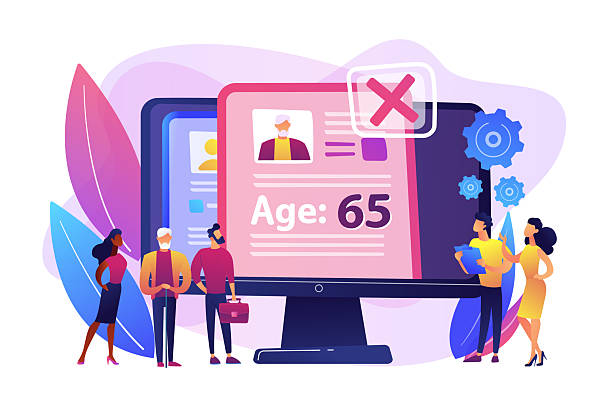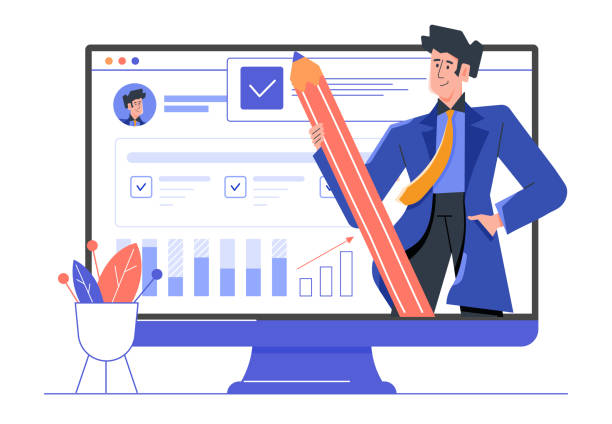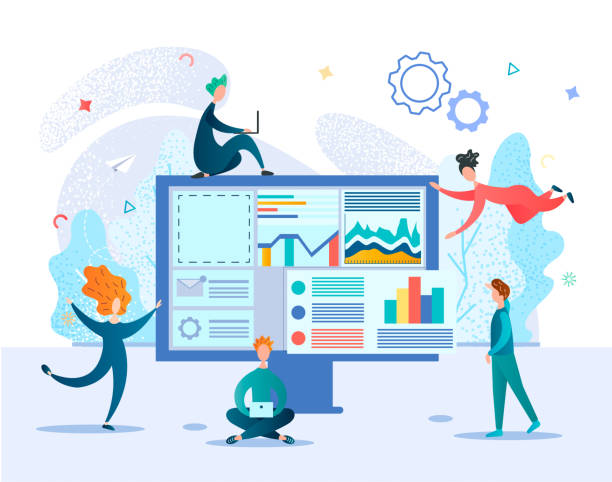The Importance of Website Speed in Today’s World

In the current digital age, where competition for user attention is momentary, the importance of website speed is more evident than ever.
Today’s users are more impatient than ever and expect web pages to load in a fraction of a second.
Any small delay can mean losing a visitor or even a potential customer.
#Fast_Website_Design is no longer a luxury option, but an undeniable necessity for any business that wants to succeed in the online space.
Research shows that even a one-second delay in page loading can lead to a 7% reduction in conversion rates and a 16% decrease in customer satisfaction.
These figures clearly demonstrate why investing in website speed optimization is vital for SEO and user experience.
Google has also long considered load speed as an important factor in ranking web pages.
Websites that load faster not only provide a better user experience but also have a higher chance of achieving higher rankings in search results.
This is especially important for e-commerce websites, where every millisecond of delay can mean financial losses.
Therefore, if you are looking to increase traffic, improve conversion rates, and enhance your position in the market, fast website design should be a priority in your plans.
Did you know that customers’ first impression of your company is your website? Multiply your business’s credibility with a powerful corporate website from Rasawb!
✅ Custom and eye-catching design tailored to your brand
✅ Improved user experience and increased customer attraction
⚡ Get a free consultation!
Key Factors Affecting Website Slowness

To achieve fast website design, we must first identify the roots of website slowness.
Many factors can affect web page loading speed, and understanding them is the first step in the optimization process.
One of the most important reasons is the high volume of images and videos with inappropriate quality and without compression.
Unoptimized images can be hundreds of kilobytes or even megabytes in size, taking a long time to load.
Excessive use of plugins and heavy JavaScript scripts can also severely impact website performance.
Each new plugin or script means more requests to the server and additional processing on the user side, leading to slowness.
Also, irregular coding without adhering to optimization standards, such as using uncompressed CSS and JavaScript or a high number of HTTP requests, can reduce site speed.
The hosting server also plays a crucial role; a server with insufficient resources or incorrect configurations, even with the best code-side optimizations, can still slow down your website.
Lack of caching, unorganized and unoptimized databases, and not using a CDN (Content Delivery Network) are other important factors.
Precisely identifying and addressing these factors is crucial for building a high-speed website.
Frontend Optimization for Faster Speed

Frontend optimization, which includes all elements processed by the user’s browser, is one of the most effective steps in fast website design.
These optimizations directly affect user experience and involve several key techniques.
The first step is image compression and optimization.
Using next-generation image formats like WebP and compressing images without noticeable quality loss can dramatically reduce overall page size.
Also, lazy loading of images and videos, meaning content is only loaded when the user needs it, prevents bandwidth waste and increases initial load speed.
In addition to images, optimizing CSS and JavaScript files is also very important.
Minification of these files, which involves removing extra characters, spaces, and comments, can reduce their size.
Merging CSS and JavaScript files to reduce the number of HTTP requests to the server is also an efficient technique.
Using async and defer attributes for scripts also helps ensure that their loading does not interfere with the loading of the main page content.
Furthermore, proper use of browser caching allows the browser to store static resources (like CSS, JS files, logo images) for subsequent visits, preventing them from being reloaded, which in turn significantly helps in creating a high-speed website.
Focusing on these frontend details will make a significant difference in the website’s final performance.
| Technique | Description | Key Benefit |
|---|---|---|
| Image Compression | Reducing image file size without significant quality loss and using optimized formats (e.g., WebP) | Reduced image loading time and bandwidth consumption |
| Minify CSS/JS | Removing extra characters, spaces, and comments from code files | Reduced file size and faster download |
| Lazy Loading | Loading content (images, videos) only when it enters the user’s viewport | Increased initial page load speed |
| Browser Caching | Storing static website files in the user’s browser for subsequent visits | Significantly increased speed for repeat visits |
Backend Optimization and Choosing Suitable Hosting

In addition to frontend optimizations, backend performance also plays a very important role in fast website design.
No matter how optimized a website is on the frontend, if its server is slow or unsuitable, it will never achieve optimal speed.
Choosing a suitable and reputable hosting with sufficient resources (RAM, CPU, and SSD disk space) is the first step.
Cheap shared hosting may seem attractive at first, but they often have limited resources and severely reduce your site’s performance during peak hours.
Better solutions include VPS (Virtual Private Server) hosting or dedicated servers, which offer more control over server resources and settings.
Database optimization is also crucial.
Large and unorganized databases can take a long time to respond.
Compression, proper indexing of tables, and removal of extra and old data are among the actions that help improve database speed.
Using server-side caching mechanisms like Redis or Memcached can significantly increase server response speed to repetitive requests.
These systems store frequently used data in the server’s fast memory, eliminating the need for frequent database queries.
Also, choosing newer protocols like HTTP/2 instead of HTTP/1.1 can help with loading speed due to its ability to send multiple requests in parallel.
Continuous monitoring of server performance and optimizing its settings, such as enabling Gzip or Brotli compression, are also important steps to ensure your website’s fast performance.
Does your company’s website create a professional and lasting first impression in the minds of potential customers? Rasawb, with its professional corporate website design, not only represents your brand’s credibility but also opens a path for your business growth.
✅ Create a powerful and reliable brand image
✅ Attract target customers and increase sales
⚡ Get a free consultation
The Role of CDN in Globally Increasing Load Speed

One of the most powerful tools for achieving fast website design, especially for a global audience, is the use of a Content Delivery Network (CDN).
A CDN is a network of distributed servers around the world that stores your website’s static content (such as images, CSS, JavaScript) close to users.
When a user visits your website, the content is delivered from the closest CDN server to them, not from your website’s main server.
This mechanism brings several key advantages.
Firstly, the shorter physical distance between the user and the content server significantly reduces latency.
This means faster page loading, especially for users located far from your main server.
Secondly, CDNs are optimized to handle high volumes of traffic and can reduce the load on your main server.
This allows the main server to focus on processing dynamic content and database requests, which in turn helps to increase overall site speed.
Thirdly, many CDNs also offer security services, such as protection against DDoS attacks, which helps with the stability and security of your website.
Popular CDNs like Cloudflare, Akamai, and Amazon CloudFront, by providing advanced caching capabilities, real-time image optimization, and file compression, ensure a fast website design experience for visitors from anywhere in the world.
Investing in a CDN is essential for websites with high traffic or international audiences.
The Impact of Speed on User Experience and Conversion Rate

Website speed is not just a technical factor; it has a direct impact on user behavior and commercial success.
In fact, fast website design fundamentally affects user experience (UX) and, in turn, improves the conversion rate.
Users who encounter slow websites quickly become frustrated and leave the page, a phenomenon known as a high Bounce Rate.
A high bounce rate indicates user dissatisfaction and can send negative signals to search engines, ultimately leading to lower rankings in search results.
On the other hand, a high-speed website conveys a sense of professionalism and credibility.
Users who experience fast and smooth pages are more likely to stay on the site, explore more, and perform desired actions (such as purchasing, signing up, or filling out a form).
In e-commerce, even a few hundred milliseconds of delay can mean millions of dollars lost in sales.
Amazon and Google have repeatedly shown in their research that every millisecond improvement in loading speed leads to a significant increase in revenue and user engagement.
This direct relationship between speed, user experience, and conversion rate is a compelling reason to prioritize website speed optimization.
A fast website not only attracts audiences but also retains them and converts them into loyal customers.
Key Tools and Metrics for Measuring Website Speed

To ensure that fast website design is truly achieved, it is necessary to regularly measure and monitor your website’s speed.
There are several tools available that help you evaluate your site’s performance and identify weaknesses.
One of the most widely used tools is Google PageSpeed Insights.
This tool gives you a speed score for desktop and mobile and offers suggestions for improvement.
It also uses Core Web Vitals metrics such as LCP (Largest Contentful Paint), FID (First Input Delay), and CLS (Cumulative Layout Shift) to evaluate the actual user experience.
Other tools like GTmetrix and Pingdom Tools also offer similar capabilities, including a complete Waterfall analysis that shows how long each resource (image, script, CSS) takes to load.
These tools allow you to identify performance bottlenecks and take necessary corrective actions.
Continuous speed monitoring using these tools is crucial for maintaining a fast and optimized website and helps you always be aware of your site’s performance status.
| Tool Name | Key Metrics | Special Features |
|---|---|---|
| Google PageSpeed Insights | LCP, FID, CLS, Performance Score (0-100) | Optimization suggestions based on real user data (Field Data) and lab data |
| GTmetrix | Performance Score, Structure Score, LCP, TBT | Full Waterfall report, page load video, details of each request |
| Pingdom Tools | Load Time, Page Size, Requests, Performance Grade | Tests from various global locations, performance and content analysis by file type |
| WebPageTest | First Byte, Start Render, Speed Index, LCP | Advanced test settings (browser, connection type, location), repeated tests for comparison |
Common Mistakes in Speed Optimization and How to Avoid Them

On the path to fast website design, there are some common mistakes that can render your efforts fruitless.
One of the biggest mistakes is ignoring image optimization.
Many designers and developers upload images without proper compression or resizing, which can drastically increase page size.
The solution is to always use image compression tools and optimized formats, and load images appropriate for their actual display size on the page.
Another mistake is excessive use of heavy plugins and scripts.
Every plugin you install adds code to the website and can affect loading speed.
You should remove unnecessary plugins and use reputable and optimized ones.
Also, improper use of caching, both on the server side and in the browser, is another common weakness.
Without caching, every time a user visits the page, all resources must be loaded from scratch.
Lack of database optimization and inefficient queries can also lead to slowness on the server side.
This problem is especially evident in large websites with a lot of content.
Finally, choosing inappropriate hosting and not monitoring server performance can undo all your optimization efforts.
To avoid these mistakes, it is necessary to have a comprehensive and systematic approach to speed optimization, use monitoring tools, and continuously review and improve your site’s performance.
Did you know your company’s website is the first point of contact for 75% of potential customers?
Your website is the face of your brand. With **Rasawb**’s corporate website design services, create an online presence that earns customer trust.
✅ Create a professional and lasting image of your brand
✅ Attract target customers and increase online credibility
⚡ Get a free consultation from **Rasawb** experts!
The Future of Web Design and Load Speed

The world of web is rapidly evolving, and the future of fast website design will also undergo continuous changes and innovations.
With the emergence of new technologies and increasing user expectations, optimization methods are also becoming more advanced.
One of the important trends is the broader adoption of Progressive Web Apps (PWAs).
PWAs offer user experiences close to native applications and significantly increase speed and interaction with features like offline storage and instant loading.
Google’s Core Web Vitals are also shaping the future of website ranking.
These metrics, which focus on real user experience, encourage developers to prioritize how users feel about website speed, rather than just speed itself.
Server-side technologies like Serverless Computing and Edge Computing are also changing how content is hosted and delivered.
These technologies allow websites to deliver content from the closest point to the user with minimal latency.
Additionally, AI-powered optimization and Machine Learning to predict user behavior and pre-load content before they request it can lead to incredible website speeds.
Finally, with the increasing use of mobile devices and 5G networks, the need for fast and extremely responsive website design will be felt more than ever, and innovations in this area will continue.
Conclusion: Investing in Website Speed

In conclusion, it is clear that fast website design is no longer an option, but a strategic necessity for any online entity.
From improving user experience and reducing bounce rates to increasing conversion rates and enhancing search engine rankings, the benefits of a high-speed website are extensive and vital.
By considering all aspects of optimization, from optimizing images and frontend code to choosing suitable hosting and using a CDN, a truly fast website can be achieved.
Investing in website speed is an investment in the future of your online business.
It not only leads to greater user satisfaction but also directly contributes to your revenue growth and brand credibility.
Modern speed measurement and monitoring tools also allow you to always be aware of your site’s performance and continuously improve it.
Don’t let website slowness prevent you from reaching your full potential in the digital space.
By focusing on these principles and applying best practices, you can ensure that your website is not only fast but always one step ahead of the competition.
Continuous optimization is key to maintaining an edge in this fast-paced arena.
Frequently Asked Questions
| Question | Answer |
|---|---|
| What is fast website design? | The process of building a website that loads quickly and provides a smooth user experience. |
| Why is website speed important? | Improved user experience, reduced bounce rate, increased conversion rate, and better search engine ranking (SEO). |
| What factors affect website speed? | Image size, number of HTTP requests, code optimization (HTML, CSS, JS), host speed, and browser cache. |
| How can website speed be improved? | Optimizing images, compressing files, using caching, choosing suitable hosting, and reducing unnecessary plugins. |
| How do images affect website speed? | Images with large sizes or inappropriate formats can significantly increase page load time. |
| What is the role of JavaScript and CSS in website speed? | Unoptimized code, large size, or blocking execution can reduce page rendering speed. |
| How much does hosting affect website speed? | The speed and quality of the hosting server directly impact the website’s response time and initial loading speed. |
| What tools are available to check website speed? | Google PageSpeed Insights, GTmetrix, Pingdom Tools are common tools. |
| What are the benefits of a fast website? | Greater user satisfaction, reduced bounce rate, increased time on site, and improved ranking in Google results (SEO). |
| What are common mistakes that slow down a website? | Using unoptimized images, bulky and unorganized coding, excessive use of plugins, and not using caching. |
And other services of Rasa Web Advertising Agency in the field of advertising
- Smart Brand Identity: A combination of creativity and technology to increase click-through rates by customizing user experience.
- Smart Conversion Rate Optimization: A creative platform for improving campaign management with Google Ad management.
- Smart Marketing Automation: A dedicated service for increasing website traffic based on Google Ad management.
- Smart SEO: An effective tool for online growth with the help of Google Ad management.
- Smart SEO: A creative platform for improving online growth with SEO-driven content strategy.
And over hundreds of other services in the field of internet advertising, advertising consultation, and organizational solutions
Internet Advertising | Advertising Strategy | Advertorials
Resources
How to improve your site speed for SEO?
Strategies for increasing traffic with fast website design
The importance of responsive design in improving site SEO
Guide to optimizing images for speed and SEO
? Ready to revolutionize your business in the digital world? Rasaweb Afarin Digital Marketing Agency, with expertise in responsive website design, SEO optimization, and professional social media management, helps you on the path to growth and achieving big goals.
📍 Tehran, Mirdamad Street, next to Bank Markazi, Kazeroon Janubi Alley, Ramin Alley No. 6



